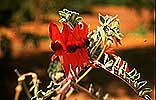In 1829-30, Capt. Charles Sturt and a party of men were given the task of answering the questions posed about the waterways.

Sturt Desert Pea, named after him.
EXPLORATION
River Exploration: Captain Charles Sturt
The Murray Darling System
|
The major settlements between Blanchetown (SA) and Gundagai (NSW) are located
on the Murray and Murrumbidgee Rivers. Both were sighted by early European settlers
as grazing lands extended west from Sydney, but their extent and places of termination
were not known.
In 1829-30, Capt. Charles Sturt and a party of men were given the task of answering the questions posed about the waterways. |  Sturt Desert Pea, named after him. |
They travelled over the known tracks as far as Gundagai and then ventured
farther west. With horsedrawn drays laden with provisions, a dismantled whaleboat,
and a small flock of sheep, they moved along the southern bank of the Murrumbidgee
to where it met the Lachlan. There they encountered high reed beds and soft,
moist ground which prevented further progress by land.
The whaleboat was assembled and a party of eight embarked on a journey
to continue farther along the course of the river.
On Jan. 14th. 1830 they were swept into the junction of the Lachlan and
Murray Rivers through a sudden narrow flow at the Lachlan mouth.
The following week they saw, and spent time exploring, the lower reaches
of a large new stream which entered the Murray from the north. Sturt correctly
guessed it was the River Darling, thereby realising the network of streams which
form Australia's largest river system.
Although supplies were running low they continued along the Murray reaching
its outlet on Feb.9th. 1830.
After 3 days of exploration they began the return journey upstream. The
task was long and arduous, and when they finally reached the depot they had
previously established at the junction of the Lachlan, it was deserted .For
17 more days they continued upstream, finally abandoning the boat and pitching
camp near the present site of Narrandera.
Two of the men were dispatched to find help. They returned a week later
as the last of the provisions were exhausted.
The findings of the expedition enabled squatters and their flocks to more
confidently move westward, extending the area of European habitation, and initiating
the townships through which present day travellers pass.

